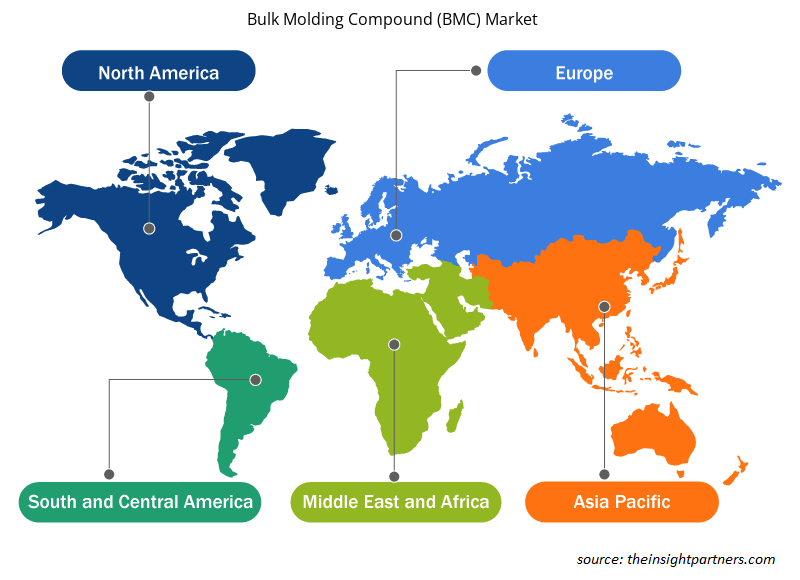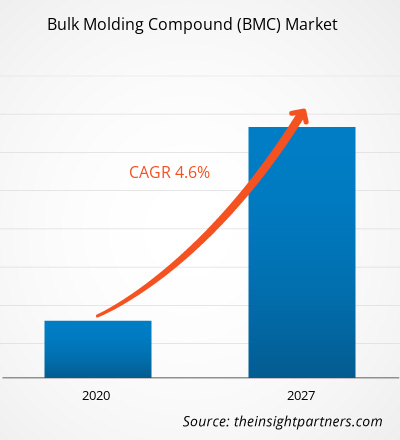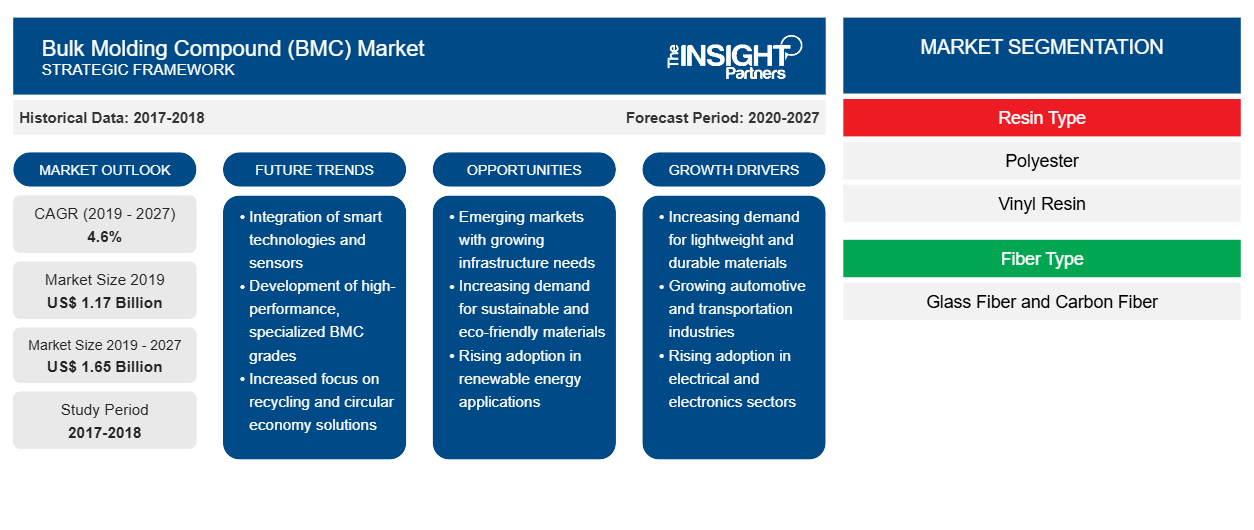Der Markt für Bulk Molding Compounds (BMC) wurde im Jahr 2019 auf 1.167,64 Millionen US-Dollar geschätzt und soll bis 2027 1.650,58 Millionen US-Dollar erreichen; im Prognosezeitraum 2020 - 2027 wird ein CAGR von 4,6 % erwartet.
Bulk Molding Compound (BMC) ist ein formfertiges, glasfaserverstärktes duroplastisches Polymermaterial, das im Kompressionsformverfahren sowie im Spritzguss- und Transferformverfahren verwendet wird. BMC wird hergestellt, indem ungesättigtes duroplastisches Harz wie Polyesterharz, Vinylesterharz oder Epoxidharz zusammen mit Strängen aus gehackten Glasfasern, Styrol, einem Initiator und einem Füllstoff in einem Mischer gemischt wird. Das Mischen zur Herstellung von BMC erfolgt bei Raumtemperatur und die Lagerung erfolgt bei niedrigen Temperaturen, um die Aushärtung vor dem Formen zu verlangsamen.
Die Nachfrage nach leichten Materialien mit hoher Zugfestigkeit steigt in mehreren Branchen, wie der Automobil-, Luft- und Raumfahrt- und Bauindustrie. Die Verwendung von leichten Materialien wirkt sich direkt auf die Gesamtdynamik und Struktur der Komponenten aus, in denen sie verwendet werden. BMC ist ein solches Verbundmaterial, das mithilfe von duroplastischen Polymermatrizen hergestellt wird. Das in Verbundwerkstoffen für die Massenformung verwendete Material besitzt mehrere Eigenschaften wie gute Formbarkeit, hohe Dimensionsstabilität, hervorragende mechanische und elektrische Eigenschaften sowie Beständigkeit gegen Chemikalien und Korrosion. Darüber hinaus ist es leicht und recht wirtschaftlich, was es zu einem idealen Bauteil für den Einsatz in mehreren Anwendungen macht. Die Nachfrage nach BMC ist in der Automobil- und Luft- und Raumfahrtindustrie aufgrund zunehmender Fortschritte und Innovationen in diesen Branchen erheblich gestiegen.
Gewicht und Festigkeit sind zwei wichtige Faktoren, die die Festigkeit eines Fahrzeugs bestimmen. Eine leichte Gewichtsreduzierung verbessert die Leistung eines Fahrzeugs. Verbundwerkstoffe sind zu einem strategischen Kernmaterial für Automobilhersteller und Luft- und Raumfahrtkomponenten geworden. Daher bietet die zunehmende Verwendung von BMC in der Automobil- und Luft- und Raumfahrtindustrie große Möglichkeiten für das Wachstum des Marktes für Bulk Molding Compounds (BMC) auf der ganzen Welt. Darüber hinaus gewinnen BMC-Verbundwerkstoffe aufgrund ihrer Eigenschaften wie Hitze- und Korrosionsbeständigkeit, Dimensionsstabilität und anderen in mehreren Elektro- und Elektronikanwendungen an Bedeutung. Angesichts der wachsenden Nachfrage nach leichten, hochfesten und feuerbeständigen Materialien in verschiedenen Endverbrauchsbranchen wird daher erwartet, dass der Markt für BMC wächst.
Nordamerika wird im Prognosezeitraum voraussichtlich den größten Anteil am globalen Markt für Bulk Molding Compounds (BMC) halten. Dies ist hauptsächlich darauf zurückzuführen, dass mehrere in- und ausländische Unternehmen in Nordamerika stark vertreten sind. Diese Unternehmen verbessern kontinuierlich ihre gesamten Geschäftsprozesse, um die Kundenanforderungen bestmöglich zu erfüllen. Die Region unterstützt das Wachstum des Marktes für Bulk Molding Compounds (BMC) weitgehend durch effektive Fertigungs- und Handelsrichtlinien. BMC ist ein faserverstärkter Polymerverbundstoff, der für seine höhere mechanische Festigkeit, hohe Dimensionsstabilität, hervorragende elektrische Eigenschaften und viele andere relative Eigenschaften bekannt ist. Aufgrund dieser Eigenschaften wird BMC in mehreren Endverbrauchsbranchen wie Automobil und Transport, Luft- und Raumfahrt sowie Bauwesen verwendet. Daher wird erwartet, dass das Wachstum dieser Branchen in der Region das Wachstum des Marktes für Bulk Molding Compounds (BMC) vorantreibt. Die Nachfrage nach BMC ist hoch und Industrieunternehmen suchen nach Möglichkeiten, ihre Geschäftstätigkeit bei verbesserten wirtschaftlichen Bedingungen auszuweiten.
Der COVID-19-Ausbruch begann im Dezember 2019 in Wuhan (China) und hat sich rasch rund um den Globus ausgebreitet. Die USA, Indien, Brasilien, Russland, Spanien, Mexiko und Argentinien gehören zu den am stärksten betroffenen Ländern mit der höchsten Zahl an COVID-19-Fällen und Todesfällen (Stand: September 2020). Die COVID-19-Pandemie beeinträchtigt Volkswirtschaften und Unternehmen aufgrund verhängter Ausgangssperren, Reiseverbote und Betriebsschließungen. Die globale Chemie- und Materialbranche ist eines der größten Unternehmen, das aufgrund von Ausgangssperren und Büroschließungen mit Lieferkettenbeschränkungen und Produktionsunterbrechungen zu kämpfen hat. All diese Faktoren haben das Wachstum des globalen Marktes für Bulk Molding Compounds (BMC) stark beeinflusst.
Passen Sie diesen Bericht Ihren Anforderungen an
Sie erhalten kostenlos individuelle Anpassungen an jedem Bericht, einschließlich Teilen dieses Berichts oder einer Analyse auf Länderebene, eines Excel-Datenpakets sowie tolle Angebote und Rabatte für Start-ups und Universitäten.
-
Holen Sie sich die wichtigsten Markttrends aus diesem Bericht.Dieses KOSTENLOSE Beispiel umfasst eine Datenanalyse von Markttrends bis hin zu Schätzungen und Prognosen.
Markteinblicke
Wachstum der Bauindustrie
Das Baugewerbe gilt als einer der dynamischsten Industriezweige, der maßgeblich zur Entwicklung besserer Gesellschaften auf der ganzen Welt beiträgt. Zu den aufkommenden Trends, die sich direkt auf das Baugewerbe auswirken, gehören die wachsende Nachfrage nach umweltfreundlichem Bauen zur Minimierung der Auswirkungen des CO2-Fußabdrucks, die Verwendung verbesserter Materialien und die Verwendung von faserverstärkten Polymerverbundstoffen zur Sanierung alternder Strukturen. Mit dem Wachstum des Baugewerbes ist die Nachfrage nach leichten und starken Materialien gestiegen, was wiederum die Nachfrage nach BMC antreibt. Diese Verbindungen werden anderen traditionellen Materialien wie Eisen, Aluminium und Stahl vorgezogen und gelten als wichtiges Material im Bereich der faserverstärkten Kunststoffe. Darüber hinaus können sie ideal eingesetzt werden, um den dynamischen Anforderungen der verarbeitenden Industrie gerecht zu werden. BMC-Verbindungen weisen mehrere Eigenschaften auf, wie z. B. geringes Gewicht, lange Lebensdauer, bessere mechanische Eigenschaften, Beständigkeit gegen Feuer, Korrosion und Chemikalien, geringe Rauchentwicklung und eine gut abriebfeste Oberfläche. Die Kombination mehrerer Eigenschaften bietet eine bessere Designvielfalt, was es zu einem besseren Material als Metalle macht. Im Bausektor wird BMC zur Herstellung von Platten für Gebäudefassaden, Sitze in Sportstadien, Wassertanks, Türverkleidungen, Zugangsschächte, Schachtabdeckungen, Kabelkanäle usw. verwendet.
Einblicke in den Harztyp
Basierend auf dem Harztyp ist der Markt für Bulk Molding Compounds (BMC) weiter segmentiert in Polyester, Vinylharz und Sonstiges. Das Segment Sonstiges ist untersegmentiert in Vinylester und Epoxidharz. Im Jahr 2019 dominierte das Polyestersegment den Markt. BMC-Verbundstoffe bestehen aus Polyesterharz gepaart mit verschiedenen Fasern. Aus Polyester hergestellte Fasern bestehen aus stabilen. Starke Ionenmoleküle, Filament, Werg und Faserfüllung sind die vier Grundformen von Polyester. Diese Verbundstoffe werden in verschiedenen Endverbrauchsbranchen verwendet, darunter Automobil, Bau und Elektronik. Im Vergleich zu anderen Harzen ist die Verarbeitung von Polyester einfach, kostengünstig und es muss nicht nachgehärtet werden. Derzeit arbeiten die Polyesterhersteller an neuen und verbesserten Formulierungen mit besseren mechanischen Eigenschaften. Polyesterharze entstehen durch die Reaktion zwischen Polyolen wie Glykol oder Ethylenglykol und zweibasischen Säuren wie Phthalsäure oder Maleinsäure. Diese ungesättigten Harze werden mit anderen Chemikalien, sogenannten Härtern oder Katalysatoren, kombiniert, wodurch neben der Wärmeentwicklung auch die Molekularstruktur der entstehenden Verbindung verändert wird.
Einblicke in den Fasertyp
Basierend auf dem Fasertyp ist der Markt für Bulk Molding Compounds (BMC) weiter in Glasfaser und Kohlefaser unterteilt. Im Jahr 2019 dominierte das Glasfasersegment den Markt. Glas ist die älteste und bekannteste Form von Hochleistungsfasern, die in verschiedenen Endverbrauchsbranchen weit verbreitet sind. Glasfasern gelten als vielseitige Materialklasse, die häufig als Verstärkungsfaser für Polymerharze wie Epoxid und ungesättigtes Polyester verwendet wird. Obwohl Glasfasern im Vergleich zu anderen Verstärkungsfasern eine geringere Steifheit aufweisen, bieten sie andere deutliche Vorteile wie hohe Festigkeit bei geringer Dichte und Kosteneffizienz. Diese Art von Fasern weist eine hohe Zugfestigkeit und gute Steifheit sowie chemische Beständigkeit auf. Im Vergleich zu Kohlefasern sind Glasfasern deutlich günstiger, weniger spröde und auf dem Markt leicht erhältlich. Darüber hinaus gelten ihre Festigkeits- und Gewichtseigenschaften im Vergleich zu anderen Metallen als ideal und sie können mithilfe von Formverfahren leicht hergestellt werden.
Einblicke in den Anwendungstyp
Basierend auf der Anwendung ist der Markt für Bulk Molding Compounds (BMC) weiter segmentiert in Elektroindustrie, Automobilindustrie und andere. Im Jahr 2019 dominierte das Segment Elektroindustrie den Markt. Elektrische Anwendungen von BMC waren einer der ersten industriellen Anwender von Verbundwerkstoffen. Das Verbundmaterial bietet im Vergleich zu Keramikteilen ein geringeres Gewicht und eine geringere Zähigkeit und verfügt über eine bessere Pigmentierfähigkeit als Phenolformmaterialien. BMC-Verbundwerkstoffe bieten eine ideale Kombination aus chemischer Beständigkeit, mechanischer Festigkeit, elektrischer Isolierung und Hitzebeständigkeit. BMC wird empfohlen, um die besten Ergebnisse zu erzielen und die Vorteile durch die Verwendung dieser Verbundwerkstoffe in der Elektro- und Elektronikindustrie zu maximieren. BMC wird in Niederspannungs- und Mittelspannungsenergiesystemen, Schränken, Anschlusskästen, Sicherungen und Schaltanlagen, Motor- und Ankerisolierungen, Verkapselung von Kabeln und elektronischen Schaltkreisen, elektrischen Komponenten mit reduziertem Oberflächenwiderstand und in Lampengehäusen verwendet. Die Möglichkeit, BMC-Verbundwerkstoffe genau an die Verarbeitungs- und Endbenutzeranforderungen anzupassen, ist ein großer Vorteil gegenüber anderen Metallen. Automobilhersteller sowie Hersteller von Elektrogeräten für den privaten Gebrauch profitieren von der Konstruktion in BMC. BMC vereint hervorragende elektrische und mechanische Eigenschaften mit guter Formbarkeit und hoher Maßgenauigkeit der fertigen Produkte.
Einige wichtige Akteure auf dem globalen Markt für Bulk Molding Compounds (BMC) sind Toray TCAC Holding BV, Core Molding Technologies., IDI Composites International und Showa Denko. Diese Unternehmen implementieren neue Produktentwicklungen sowie Fusions- und Übernahmestrategien, um den Kundenstamm zu vergrößern und weltweit bedeutende Marktanteile zu gewinnen, was ihnen wiederum ermöglicht, ihren Markennamen auf dem Weltmarkt zu behaupten.
Regionale Einblicke in den Bulk Molding Compound (BMC)-Markt
Die regionalen Trends und Faktoren, die den Markt für Bulk Molding Compound (BMC) während des Prognosezeitraums beeinflussen, wurden von den Analysten von Insight Partners ausführlich erläutert. In diesem Abschnitt werden auch die Marktsegmente und die Geografie von Bulk Molding Compound (BMC) in Nordamerika, Europa, im asiatisch-pazifischen Raum, im Nahen Osten und Afrika sowie in Süd- und Mittelamerika erörtert.

- Erhalten Sie regionale Daten zum Bulk Molding Compound (BMC)-Markt
Umfang des Marktberichts zu Bulk Molding Compound (BMC)
| Berichtsattribut | Details |
|---|---|
| Marktgröße im Jahr 2019 | 1,17 Milliarden US-Dollar |
| Marktgröße bis 2027 | 1,65 Milliarden US-Dollar |
| Globale CAGR (2019 - 2027) | 4,6 % |
| Historische Daten | 2017-2018 |
| Prognosezeitraum | 2020–2027 |
| Abgedeckte Segmente |
Nach Harztyp
|
| Abgedeckte Regionen und Länder |
Nordamerika
|
| Marktführer und wichtige Unternehmensprofile |
|
Marktteilnehmerdichte für Bulk Molding Compound (BMC): Auswirkungen auf die Geschäftsdynamik verstehen
Der Markt für Bulk Molding Compounds (BMC) wächst rasant, angetrieben durch die steigende Nachfrage der Endverbraucher aufgrund von Faktoren wie sich entwickelnden Verbraucherpräferenzen, technologischen Fortschritten und einem größeren Bewusstsein für die Vorteile des Produkts. Mit steigender Nachfrage erweitern Unternehmen ihr Angebot, entwickeln Innovationen, um die Bedürfnisse der Verbraucher zu erfüllen, und nutzen neue Trends, was das Marktwachstum weiter ankurbelt.
Die Marktteilnehmerdichte bezieht sich auf die Verteilung der Firmen oder Unternehmen, die in einem bestimmten Markt oder einer bestimmten Branche tätig sind. Sie gibt an, wie viele Wettbewerber (Marktteilnehmer) in einem bestimmten Marktraum im Verhältnis zu seiner Größe oder seinem gesamten Marktwert präsent sind.
Die wichtigsten auf dem Markt für Bulk Molding Compounds (BMC) tätigen Unternehmen sind:
- ASTAR SA
- Kernformtechnologien
- IDI Composites International
- Toray TCAC Holding BV
- MENZOLIT
Haftungsausschluss : Die oben aufgeführten Unternehmen sind nicht in einer bestimmten Reihenfolge aufgeführt.

- Überblick über die wichtigsten Akteure auf dem Markt für Bulk Molding Compounds (BMC)
Markt für Bulk Molding Compounds (BMC) nach Harztyp
- Polyester
- Vinylharz
- Sonstiges
Markt für Bulk Molding Compound (BMC) nach Fasertyp
- Glasfaser
- Kohlefaser
Bulk Molding Compound (BMC) Markt, nach Anwendung
- Elektroindustrie
- Automobilindustrie
- Sonstiges
Firmenprofile
- Astar SA
- Kernformtechnologien
- IDI Composites International
- Toray TCAC Holding BV
- Menzolit
- PolyntSpA
- Showa Denko KK
- Dasyc SA
- Lorenz Kunststofftechnik GMBH
- HGGC, LLC
- Historische Analyse (2 Jahre), Basisjahr, Prognose (7 Jahre) mit CAGR
- PEST- und SWOT-Analyse
- Marktgröße Wert/Volumen – Global, Regional, Land
- Branchen- und Wettbewerbslandschaft
- Excel-Datensatz
Aktuelle Berichte
Erfahrungsberichte
Grund zum Kauf
- Fundierte Entscheidungsfindung
- Marktdynamik verstehen
- Wettbewerbsanalyse
- Kundeneinblicke
- Marktprognosen
- Risikominimierung
- Strategische Planung
- Investitionsbegründung
- Identifizierung neuer Märkte
- Verbesserung von Marketingstrategien
- Steigerung der Betriebseffizienz
- Anpassung an regulatorische Trends























 Kostenlose Probe anfordern für - Markt für Bulk Molding Compound (BMC)
Kostenlose Probe anfordern für - Markt für Bulk Molding Compound (BMC)